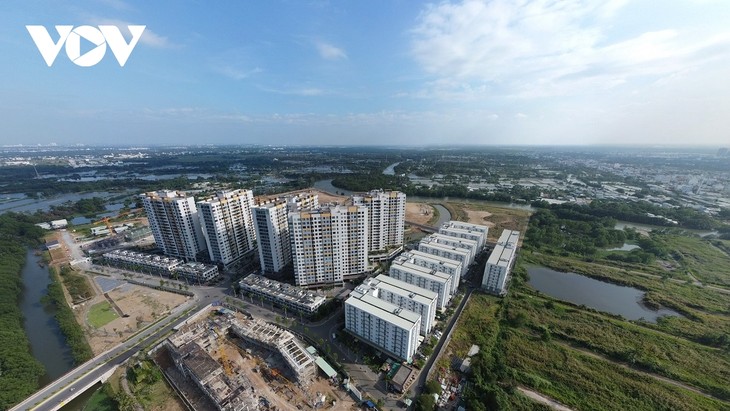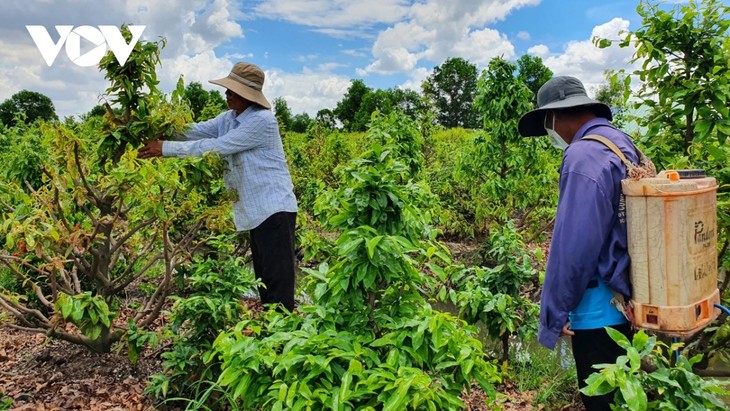(VOVWORLD) - Despite its overpopulation and underdeveloped infrastructure, Binh Chanh, one of the suburban districts of Ho Chi Minh City, has over the past decade completed the national target program on creating new-style rural areas. This work has significantly changed the face of rural areas, transformed the economic structure with many effective models, and improved people’s living standards.
 Many new residential areas and social housing projects have been built to meet Binh Chanh’s urban development needs. Many new residential areas and social housing projects have been built to meet Binh Chanh’s urban development needs. |
Many farmers in Binh Loi commune in Binh Chanh district used to find it difficult to survive on their sugarcane plantations due to the low-quality alkaline soil. When sugarcane depreciated in value, they looked to other crops for replacement. Yellow apricot was one of their choices.
The farmers borrowed capital from local funding sources to invest in planting apricot gardens, gradually expanding them, and have earned many thousands of US dollars in revenue each year. For each New Year season alone, after deducting expenses of various kinds, Binh Loi apricot growers have earned up to 13,000 USD by selling yellow apricot seedlings and apricot pots.
 The lives of farmers in Binh Chanh have become better-off thanks to the decision to grow yellow apricot trees. The lives of farmers in Binh Chanh have become better-off thanks to the decision to grow yellow apricot trees. |
Binh Loi commune is also famous for raising ornamental Japanese koi fish and planting orchid gardens, bringing a tidy income for local people. Local koi fish have even been exported to Japan and several other Southeast Asian countries.
Now Binh Chanh district can develop a service economy thanks to the application of high tech to agriculture.
Nguyen Minh Hoang, Chairman of Binh Loi commune People’s Committee, said, “Based on new rural building criteria, we recommended an appropriate amount of investment in infrastructure. In addition to developing rural economy, we’ve promoted eco-tourism and community-based tourism.”
Located at the western gateway of Ho Chi Minh City, Binh Chanh’s population is nearly 850,000 people and increases by 30,000 people on average each year, living mainly in Vinh Loc A and Vinh Loc B commune.
The overpopulation plus more than 160 scrap collection establishments there are seriously polluting the living environment in many places.
In 2015, Binh Chanh achieved 18 of the 19 criteria established for new-style rural building programs but it was not until the end of 2020 that the remaining environmental work was completed, making it the last district in Ho Chi Minh City to complete the new-style rural building program.
The district's per capita income in 2020 was more than 3,000 USD, four times higher than in 2010.
There are no poor households with income of less than 917 USD per person per year, but only 534 households with annual per-capita income of more than 1,200 USD.
Tran Thi Ngoc Thao of Da Phuoc commune in Binh Chanh said “Local people have strongly responded to the new-style rural building program under which roads have been upgraded, making it more convenient for them to travel and participate in trading activities. In addition, the municipal administration has also offered many other support measures in regards to product outputs and sales, as well as providing capital for production.”
Binh Chanh has been oriented to become the center of the economic, industrial, handicraft, trade, service, and technical infrastructure of HCMC in the southwest. Nearly 25,000 businesses, 17,000 business households, 4 industrial parks, and 1 industrial cluster are operating in the locality.
Between 2016 and 2020, Binh Chanh's economic growth reached more than 20.5% a year, in which industry and construction grew nearly 21%, accounting for 80% of the local economic structure and becoming a driver of growth, while the proportion of the agriculture sector has gradually been reduced.
Binh Chanh is developing a program to upgrade itself into a city. A transportation infrastructure connecting neighboring provinces is also on the table.
Pham Van Luy, acting Chairman of the district People’s Committee, told VOV, “The rural areas that have been invested are required to maintain the outcomes so far. In addition, it’s necessary to mobilize capital and human resources from people and the business community for several construction works and investment in transport infrastructure and social housing to improve the local living standards. This is Binh Chanh’s roadmap to gain future sustainable development.”
Completing the new-style rural building project is important for Binh Chanh in improving people's living standards and fostering its economic transformation and agricultural restructuring.